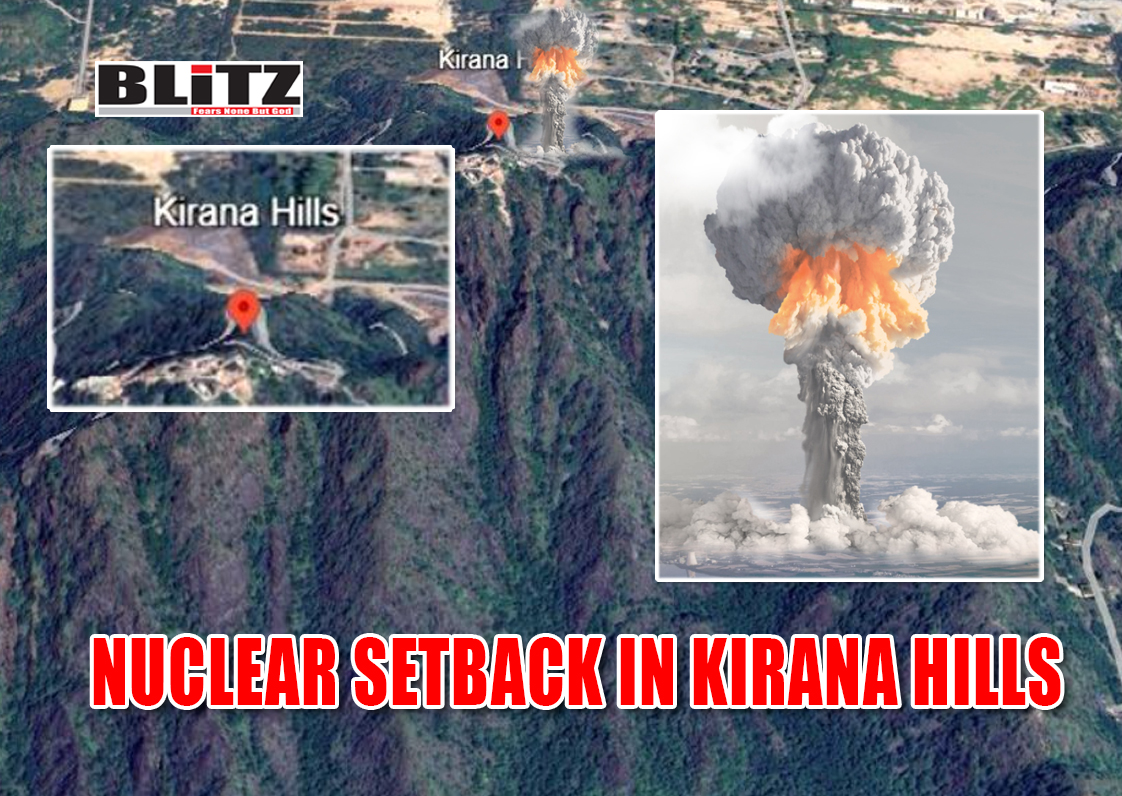Pakistan’s nuclear secrets on the brink: Punjab at the risk of Chernobyl-scale disaster
In what could evolve into one of the gravest nuclear incidents in South Asia, Pakistan’s Punjab Province may be teetering on the edge of a catastrophic disaster. Following escalating tensions with India and military confrontations during the recent “Operation Sindoor”, credible sources have raised alarm over a major nuclear setback centered in the Kirana Hills of Sargodha District -home to suspected underground nuclear facilities.
Reports suggest that a missile, initially intended to strike Indian territory, malfunctioned and exploded near the launching site within Pakistani borders. This incident, kept tightly under wraps by the Pakistani military and intelligence agencies, may have triggered a chain of events bearing haunting resemblance to the 1986 Chernobyl disaster in the former Soviet Union.
Nuclear silence and shadows in Kirana Hills
Kirana Hills has long been suspected of hosting a concealed network of nuclear weapons storage facilities, deeply embedded in fortified military zones near Sargodha Air Base. While Indian Air Force officials have firmly denied targeting the area during Operation Sindoor, a brief comment by Air Marshal AK Bharti during a press conference – “Thank you for telling us Kirana Hills houses nuclear installations” – raised eyebrows and hinted at deeper geopolitical sensitivities.
In the aftermath of the military operation, social media began to flood with footage allegedly showing abandoned homes and villages around Kirana Hills. Unverified videos depict scenes of hurried evacuations, empty streets, and military convoys. Some accounts claim that the Pakistan Army is forcibly evacuating local populations to contain a potential radiological threat – a claim further fueled by the military’s ongoing efforts to censor discussions around radiation leaks.
Local journalists attempting to report on the matter have been denied access to nuclear zones. Posts on social media containing keywords like “radiation”, “leak”, or “nuclear accident” are reportedly being systematically taken down by government-controlled agencies. Activists and online watchdogs have raised alarms over this digital blackout, accusing the Pakistani authorities of suppressing public health information.
From Chernobyl to Sargodha: Echoes of a tragedy
To draw a comparison, the Chernobyl disaster released an estimated 400 times more radioactive material than the Hiroshima and Nagasaki bombings combined. The radioactive fallout contaminated approximately 100,000 square kilometers across Ukraine, Belarus, and Russia, with trace radiation levels even detected across Western Europe.
In Pakistan’s case, while the scale of contamination remains unverified due to lack of transparency, eyewitness accounts paint a worrying picture. Residents around suspected impact zones in Punjab, particularly near Sargodha and Nur Khan Airbase, have reported a sudden rise in unexplained illnesses. Medical professionals cite a spike in persistent high fevers, unusual skin lesions, chronic respiratory problems, and neurological symptoms – ailments strongly indicative of exposure to radioactive materials.
Adding to the mystery, international flight-tracking data has revealed unusual aircraft activity over Pakistan. One such aircraft, the American Beechcraft B350 AMS, known for its role in nuclear incident detection and radiological mapping, was briefly observed in Pakistani airspace. This plane, equipped with gamma-ray sensors and radiation detectors, has previously been deployed during events such as the Fukushima disaster. Its rare appearance in foreign airspace – especially over a conflict zone – has sparked intense speculation.
Some Open Source Intelligence (OSINT) analysts pointed out that the tail number of the aircraft matched a plane originally transferred to Pakistan’s Army Aviation in 2010. Even if operated locally now, its configuration for nuclear response raises serious questions about why it was airborne following Operation Sindoor.
Foreign powers in the shadows
The situation has further escalated with reports of military aircraft from both the United States and Egypt landing at undisclosed locations within Pakistan. One Egyptian Air Force flight (EGY1916), reportedly carrying boron – a chemical used to contain nuclear reactions – took off from Bhurban (Murree) after a stop in China, according to flight-tracking services.
While no official statements have been released by either Islamabad or foreign governments regarding the purpose of these visits, analysts believe that these flights may be part of a covert operation aimed at securing or neutralizing Pakistan’s nuclear assets. The possibility that foreign powers are now directly involved in preventing a nuclear catastrophe speaks volumes about the gravity of the situation.
Nur Khan and Dera Ghazi Khan: Other critical flashpoints
Pakistan has confirmed that Indian missiles struck the Nur Khan and Sargodha Airbases during the latest military clashes. These sites, located near Islamabad and in central Punjab respectively, are not just strategic airbases but also key logistics centers tied to Pakistan’s military and nuclear programs.
Another area under scrutiny is Dera Ghazi Khan, home to former uranium mines and a nuclear waste dump site in the Koh-i-Sulaiman mountain range. Long known for improper handling of radioactive waste, the region has experienced high incidences of bone, liver, and cancer-related diseases -problems documented extensively by global journals such as The Diplomat. Any radiological destabilization in this area could compound already dire health and environmental conditions.
A nation in denial?
What makes the situation particularly perilous is Islamabad’s persistent silence. The absence of an official statement addressing the alleged nuclear mishap has only deepened suspicions. Instead of clarifying the matter to prevent public panic, Pakistani authorities appear to be engaged in a campaign of information suppression, further eroding trust among citizens and the international community.
This opacity risks turning a potential environmental and humanitarian crisis into a full-scale catastrophe. If radiation has indeed leaked into surrounding regions, immediate public health interventions and evacuations are essential. Delaying such actions – especially in pursuit of political or military cover-ups -can lead to irreversible damage.
Fallout beyond borders
The potential implications of a nuclear mishap in Pakistan are not limited to national boundaries. Punjab is one of the most densely populated and agriculturally productive provinces in the country. Radioactive contamination here could severely impact food security and water safety across the region, affecting millions and possibly spilling into neighboring India.
Crops could absorb radioactive particles, livestock could suffer high mortality rates, and entire water systems could become unsafe for human consumption. The cascading effects could mirror, or even surpass, those seen in post-Chernobyl Eastern Europe – where entire regions were declared uninhabitable for decades.
Did Pakistan trigger its own nuclear crisis?
The emerging narrative suggests that Pakistan may have inadvertently initiated its own nuclear crisis through provocative military actions. The recent Pahalgam massacre – allegedly orchestrated by the Pakistan Army and ISI -prompted India’s robust military response under Operation Sindoor. In its attempt to demonstrate deterrence or retaliation, Pakistan may have mishandled one of its own nuclear assets, resulting in the current debacle.
This begs the question: has Pakistan, in its zeal to provoke India, risked a form of nuclear suicide? Was it worth endangering millions of lives and contaminating its own heartland just to flex strategic muscle?
The clock is ticking
Pakistan stands at a dangerous crossroads. If the nuclear setback in Kirana Hills and other sites is as serious as emerging evidence suggests, the country must urgently abandon denial and adopt full transparency. International agencies, including the IAEA and the World Health Organization, should be granted immediate access to assess and mitigate the damage.
Time is of the essence. The health of tens of thousands, the safety of an entire province, and regional stability hang in the balance. Ignoring or concealing the truth can no longer be an option – for Pakistan, or for the world.
Please follow Blitz on Google News Channel
An internationally acclaimed multi-award-winning anti-militancy journalist, writer, research-scholar, counterterrorism specialist and editor of Blitz. He regularly writes for local and international newspapers on diversified topics, including international relations, politics, diplomacy, security and counterterrorism. Follow him on ‘X’ @Salah_Shoaib
pakistans-nuclear-secrets-on-the-brink-punjab-at-the-risk-of-chernobyl-scale-disaster















Leave a Reply